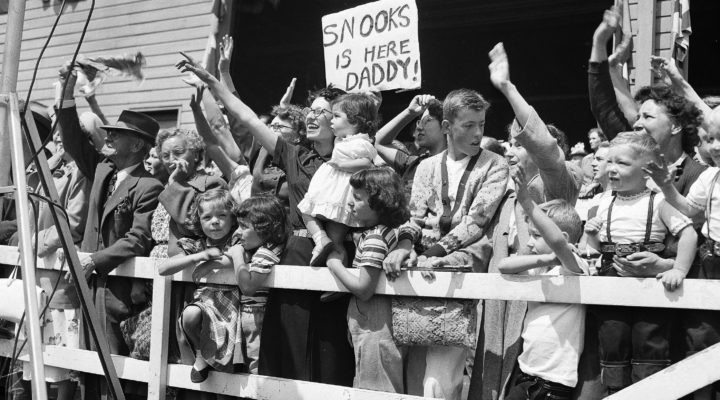You can blame this editorial on my mother’s 20-year-old Ford Explorer. I responded to the sudden flash of the engine light as I was recently driving Interstate 20 in northwest Louisiana. I darted to her highly utilized mechanic, who continues to massage this machine into another thousand miles. While I waited for the engine check, I was captivated by the booming sounds overhead. It took a moment to realize what was happening and where I stood. I wasn’t in Quaker-founded Whittier, Calif., anymore.
It was the day before the Barksdale Air Force Base Defenders of Liberty Air and Space Show, an annual event showcasing air defense technology and skills. Barksdale is home to the 2nd Bomb Wing, Air Force Global Strike Command, 8th Air Force, the 307th Bomb Wing, and other partners that provide strategic global support. More than 15,000 active duty and Air Force Reserve troops serve at Barksdale. It’s a big boy as bases go.

Marianne Hebert

Paula Mangum Sheridan
Several fighter jets flashed across the sky with speed and skill. Bombers lumbered behind, less dramatic but still daunting. The aerial ballet was sublime. But it also demonstrated the lethal force of our defense weapons, the fancy planes we use to win wars.
President Biden recently announced that U.S. forces serving in Afghanistan will depart by mid-July, prior to the 20-year observance for the Sept. 11 attacks that forged military action. The drawdown date for 3,000 troops began May 1, former President Trump’s initial timeline for the departure. Our longest war dominated the efforts of now a fourth president and two decades. During this time, about 775,000 troops served — and 2,300 American troops and more than 38,000 Afghan civilians died.
The Gulf War is controversial and highly debated in government, communities and backyard barbeques. Regardless of our stance, the endless war became an invisible war. Eventually, the media focused more on presidential tweets than military action overseas. If we aren’t attending to them overseas, what will we do when they come home? What have we done when troops returned home the past two decades?
Each war has characteristics defined by geography, mission and contemporary issues during wartime. World Wars I and II were more clearly focused on specific enemies, with a growing national consensus of support.
“With each war era, our service members experience physical and mental challenges as warriors.”
Now the largest population of veterans, Vietnam veterans, served under challenging political and social opposition, bearing the brunt of American disapproval when they returned home. Some carried burdens of physical and psychological injuries, such as post-traumatic stress syndrome. The cluster of symptoms was recognized as a mental health condition in 1980, five years after the end of that war, even though troops experienced similar symptoms for hundreds of years.
The Gulf War veterans deployed and returned home over a prolonged period and taught us about the lingering effects of traumatic brain injuries in addition to post-traumatic stress. With each war era, our service members experience physical and mental challenges as warriors. Some also suffer discrimination within the ranks due to sex, race, sexual orientation or other socially constructed identities.
How can we support the families and service persons who served in the Gulf War? We know them as neighbors, work colleagues, church members, family and friends.
Here is a resource list to get us going:
First, learn the basics about military branches and basic information about each service branch: Marine Corps, Navy, Air Force, Space Force, Coast Guard. Some branches include part-time service such as reserve units.
Second, know the ranks in different branches of service. We are more inclusive when we take responsibility for learning basic military information and vocabulary.
“We are more inclusive when we take responsibility for learning basic military information and vocabulary.”
Third, educate yourself about military deployment, service and reintegration into civilian life that includes the family, not just the service member. There are resources for children, military spouses, and family members.
Fourth, consider the strengths service personnel offer to the workplace and community. Military personnel demonstrate agility in problem-solving and function as a part of a team. Veterans are likely to be loyal, reliable and get the job done. They develop a “got your six” loyalty that watches your back. These are significant contributions to family and civic life.
Fifth, be attentive and supportive to the needs of LGBTQ service members and veterans as they navigate stigma and acceptance.
Sixth, understand that women veterans may have needs more specialized to their deployment experiences. Women are more likely to be sexually harassed or abused by their fellow troops or superior officers. A 2014 RAND Military Workplace Study of about 560,000 service members found that sexual harassment is a common experience for women in military service (22% of active servicewomen and 7% of men). Also, 4.9% of women and 1% of men were sexually assaulted in the year before data collection. An estimated 20,300 out of 1.3 million active-duty members encountered sexual assault.
Seventh, think of concrete ways to show hospitality.
- Male veterans call one another “brother.” If your congregation has veterans, this may be a ready connection in reaching out to the returning veteran.
- Consider hosting a Veterans Day (Nov. 11) church service or celebration. Invite veterans and their families from your city or neighborhood.
- Reach out to veterans as you would a new church member, colleague or neighbor.
- Ask the veteran to tell their own story. Don’t assume that you know what happened or how a veteran feels.
- Listen, respectfully. Honor their dignity. Their service is independent of our political views.
- Thank a veteran for the contributions and sacrifices they made.
Eighth, allow time and space for multiple adjustments. The skills that kept troops safe may not work for civilian life. Sometimes family and friends are eager to host gatherings and plan events. Perhaps the veteran may want to keep it simple as one reacclimates. It may take a while to eat in a crowded restaurant without hypervigilance, look at a garbage can without wondering if it is an explosive device (IED), and move around without one’s weapon.
“The veteran’s family life changes upon return.”
The veteran’s family life changes upon return. Chores, rules, authority, alliances and other dynamics can seem confusing at first. What is it like to reunite with an intimate partner? How do you adjust as a couple and a family? Who takes out the garbage? Who controls the TV remote? Families may teeter between walking on eggshells to being unaware of the veteran’s needs.
When a veteran or family member needs support, there is a Veteran’s Crisis Line, a 24-7 service accessible at (800) 273-8255. (Veterans Press 1.)
We long for the day when this conversation is unnecessary and irrelevant. Until then, may we follow the arc of our military personnel and their families from enlistment to reintegration at home. They are our children, our parents, our neighbors, our church members. Their well-being should be independent of our political persuasions. Let’s give them our best when they come home.
Paula Mangum Sheridan recently retired from Whittier College as an associate professor and program director of the social work department. She is a licensed clinical social worker and supports voter accessibility and the rights of people without homes in her community. Marianne Hebert is a licensed clinical social worker recently retired from the Southeast Louisiana Health Care System in New Orleans.


